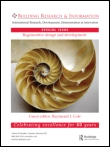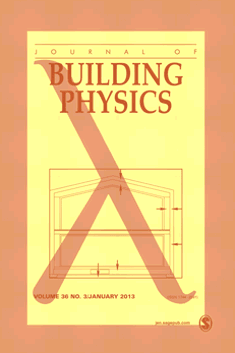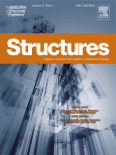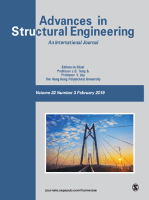
Journal of Building Engineering
Scope & Guideline
Transforming Ideas into Architectural Reality
Introduction
Aims and Scopes
- Sustainable Building Materials and Practices:
The journal emphasizes the development and application of sustainable materials, including recycled aggregates, geopolymer concrete, and bio-based composites, aiming to reduce the environmental impact of construction. - Energy Efficiency and Thermal Performance:
Research articles often explore energy-efficient building designs, optimization of HVAC systems, and thermal performance assessments to enhance occupant comfort while minimizing energy consumption. - Structural Performance and Resilience:
The journal covers studies on the structural integrity and resilience of buildings, particularly under extreme conditions such as earthquakes, floods, and fire, focusing on innovative design and retrofitting techniques. - Advanced Computational Methods and Machine Learning:
There is a notable focus on the integration of machine learning and computational modeling to predict building performance, optimize design processes, and improve energy management systems. - Indoor Environmental Quality and Health:
Research addressing the impact of building design on indoor air quality, thermal comfort, and overall occupant health and well-being is a key area of interest, reflecting the growing awareness of health-related issues in building engineering.
Trending and Emerging
- Smart Buildings and IoT Integration:
There is a growing trend towards research on smart building technologies that leverage IoT for enhanced monitoring, control, and optimization of building systems, reflecting the rise of smart cities. - Resilient Design Strategies:
Emerging themes include the design of buildings that can withstand and recover from extreme weather events, focusing on resilience and adaptability in the face of climate change. - Carbon Neutral and Low-Carbon Materials:
Research is increasingly directed towards materials and construction techniques that contribute to carbon neutrality, such as carbon capture technologies, low-carbon cements, and energy-efficient designs. - Health and Well-Being in Building Design:
The intersection of building design and occupant health is gaining attention, with studies focusing on how design choices impact mental and physical well-being. - Advanced Materials and Nanotechnology:
The use of nanotechnology and advanced materials, such as graphene and bio-based composites, is becoming more prevalent, emphasizing innovation in material properties and applications.
Declining or Waning
- Traditional Construction Techniques:
There has been a noticeable decrease in papers focusing on conventional construction methods as more emphasis shifts towards innovative and sustainable practices, such as 3D printing and advanced materials. - Basic Building Codes and Standards:
Research centered on basic building codes and regulations has declined, possibly due to the increasing complexity and specificity of modern building practices that require more nuanced approaches. - Historical Building Preservation:
While still relevant, studies specifically dedicated to the preservation of historical buildings are becoming less frequent as the journal pivots towards contemporary building technologies and sustainability. - Generalized Energy Use Studies:
There is less focus on broad energy consumption studies without specific innovations or technologies, as the journal increasingly prioritizes detailed analyses of specific systems or components. - Conventional HVAC Systems:
Research on traditional HVAC systems is dwindling as more articles explore advanced, integrated, or renewable energy-based alternatives, reflecting a shift towards innovative energy solutions.
Similar Journals

Building Simulation
Unlocking the Potential of Sustainable ArchitectureBuilding Simulation is a leading academic journal published by TSINGHUA UNIVERSITY PRESS, focusing on the critical intersection of building and construction and energy efficiency. With its ISSN 1996-3599 and E-ISSN 1996-8744, this journal stands out in the Q1 category for both Building and Construction and Energy (miscellaneous), as recognized in the latest 2023 category quartiles. It has established itself as an influential platform for disseminating innovative research and developments in building performance simulation and energy use optimization, boasting impressive Scopus rankings at Rank #15/223 in Engineering (Building and Construction) and Rank #15/78 in Energy (miscellaneous), placing it in the upper percentiles of its field. Since its inception in 2008, the journal has fostered a rich dialogue among practitioners, researchers, and students, empowering them to advance sustainable building practices and contribute to global energy conservation efforts. Building Simulation is an open-access journal, making its valuable content accessible to a worldwide audience, further enhancing its role as a vital resource in the quest for innovative building solutions.

BUILDING RESEARCH AND INFORMATION
Exploring innovative solutions in Civil and Structural Engineering.BUILDING RESEARCH AND INFORMATION is a premier academic journal dedicated to the advancement of knowledge in the fields of Building and Construction as well as Civil and Structural Engineering. Published by Routledge Journals, Taylor & Francis Ltd, this journal boasts an impressive Q1 ranking in both categories as of 2023, emphasizing its reputation for disseminating high-quality research. Established in 1991, it has continually provided a vital platform for scholarly dialogue on innovative building practices, sustainable construction techniques, and cutting-edge engineering solutions, with ongoing contributions accepted until 2024. The journal is renowned for its extensive insights and interdisciplinary approach, and with a Scopus rank placing it in the 88th percentile for both building and construction engineering and civil and structural engineering, it presents an exceptional opportunity for researchers, professionals, and students to engage with and publish influential findings. While the journal is not open access, it remains a cornerstone for those aiming to deepen their understanding of contemporary challenges and trends in the built environment.

Journal of Building Physics
Innovating Building Performance for a Sustainable FutureThe Journal of Building Physics, published by SAGE PUBLICATIONS LTD, has established itself as a leading publication within the fields of Building and Construction as well as Materials Science. With a robust Scopus ranking, including a commendable Q2 designation in both categories in 2023, this journal serves as a crucial platform for researchers and professionals aiming to advance the understanding of building performance and thermal dynamics. Operating from the vibrant academic landscape of the United Kingdom, the journal showcases innovative research and critical analyses that enhance sustainable building practices, contributing significantly to the literature from 2000 to 2024. Though it does not currently offer open access, the Journal of Building Physics continues to publish highly-cited work that resonates with its audience, facilitating knowledge exchange and encouraging scholarly dialogue among students, practitioners, and researchers eager to push the boundaries of building sciences.

Journal of Architectural Engineering
Shaping Sustainable Environments Through Innovative EngineeringThe Journal of Architectural Engineering, published by the ASCE (American Society of Civil Engineers), stands as a pivotal resource in the interdisciplinary fields of architecture and engineering. With an ISSN of 1076-0431 and E-ISSN 1943-5568, this journal has garnered a notable reputation since its inception in 1995, currently converging towards 2024. Boasting a Q1 ranking in Architecture and Visual Arts and Performing Arts, alongside respectable Q3 rankings in Building and Construction and Civil and Structural Engineering, the journal places itself in the elite class of scholarly publications, evidenced by its impressive Scopus rankings. Its commitment to providing cutting-edge research ensures comprehensive coverage across various aspects of architectural engineering, facilitating robust interdisciplinary dialogues. Although the journal operates under a traditional access model, its impact on the academic community remains profound, making it an essential platform for researchers, professionals, and students who seek to push the boundaries of knowledge in their respective fields. This journal not only aims to stimulate innovative ideas but also fosters a collaborative environment for advancing sustainable architectural practices in a rapidly evolving built environment.

Journal of Green Building
Connecting Ideas for a Sustainable Built EnvironmentJournal of Green Building, with its ISSNs 1552-6100 and 1943-4618, is a premier academic journal published by COLLEGE PUBLISHING in the United States. This journal, established in 2006 and continuing through 2024, serves as a vital platform for the dissemination of research on sustainable architecture, building technologies, and environmental design. With its current impact factor signifying a robust academic contribution, it is categorized in Q2 in Architecture and Q3 across several other disciplines, including Building and Construction, Environmental Engineering, and Public Health. The journal’s Scopus rankings demonstrate its strong positioning in the engineering and environmental science communities, making it an essential resource for researchers and professionals aiming to advance knowledge in green building practices. While it is not an Open Access journal, the rich content is pivotal for those involved in the critical intersection of sustainability and construction science. Whether you are a seasoned professional or a dedicated student, the Journal of Green Building offers invaluable insights that drive future innovations in eco-friendly building environments.

Intelligent Buildings International
Pioneering the Future of Smart Building TechnologiesIntelligent Buildings International, published by Taylor & Francis Ltd, is a premier journal dedicated to advancing knowledge in the interdisciplinary domains of building construction, civil engineering, computer science applications, and planning. Since its inception in 2009, this journal has become a vital resource for researchers, professionals, and students, offering a platform for high-quality scholarly articles that explore innovative strategies and technologies in intelligent building design and efficiencies. With its significant impact factor reflected in its Q2 and Q3 quartile rankings across various related fields, and strong Scopus rankings placing it among the top journals in Geography, Building, and Civil Engineering, Intelligent Buildings International stands out for its commitment to fostering research that enhances the sustainability and functionality of contemporary architectural practices. Readers can access a wealth of articles that illuminate the complexities of smart building technologies and their implications for future construction practices, making it an essential addition to any academic library.

Structures
Building Knowledge for a Resilient TomorrowStructures is a premier interdisciplinary journal published by Elsevier Science Inc, dedicated to advancing the fields of architecture, building and construction, civil and structural engineering, and safety, risk, reliability, and quality. With its ISSN 2352-0124, this scholarly journal showcases cutting-edge research and innovative practices that drive the evolution of structural design and analysis. Since its establishment in 2015, Structures has swiftly garnered high esteem, achieving a Q1 ranking in four key categories as of 2023, and placing within the top percentiles in various engineering disciplines, making it an essential resource for industry professionals, researchers, and students alike. The journal promotes a comprehensive understanding of contemporary challenges and solutions within its scope, providing a platform for disseminating impactful research. Access options may vary, but the commitment to high-quality, peer-reviewed content remains a constant in fostering academic growth and industry advancement.

ADVANCES IN STRUCTURAL ENGINEERING
Fostering Collaboration for Sustainable Construction SolutionsADVANCES IN STRUCTURAL ENGINEERING, published by SAGE PUBLICATIONS INC, is a leading journal dedicated to the advancement of knowledge in the fields of Building and Construction, as well as Civil and Structural Engineering. With a solid impact factor and a commendable Scopus ranking (Rank #60 in Building and Construction, Rank #105 in Civil and Structural Engineering), this journal stands at the forefront of academic research, providing a platform for high-quality articles that contribute significantly to the discipline. Covering a range of topics from innovative construction techniques to sustainable engineering practices, the journal aims to foster collaborative dialogue among researchers, industry professionals, and students alike. As of 2023, it boasts impressive category quartiles, ranking Q1 in Building and Construction and Q2 in Civil and Structural Engineering. ADVANCES IN STRUCTURAL ENGINEERING is a vital resource for those looking to stay abreast of emerging trends and groundbreaking developments in structural engineering, promoting an environment of continuous learning and application of best practices. With a convergence of research from 1999 to 2024, the journal not only emphasizes theoretical frameworks but also bridges the gap between academia and practical application in engineering projects.

Bauingenieur
Bridging Theory and Practice in Engineering DiscoursesBauingenieur, an established journal in the field of Building and Construction and Civil and Structural Engineering, has been a significant platform for scholarly discourse since its inception in 1969. Published by VDI FACHMEDIEN GMBH & CO KG UNTERNEHMEN FACHINFORMATIONEN in Germany, this journal, available in both print (ISSN: 0005-6650) and electronic formats (E-ISSN: 1436-4867), serves as a vital resource for researchers, professionals, and students dedicated to advancing knowledge and practice in engineering. Although currently without open access options, Bauingenieur aspires to contribute to the academic community by presenting cutting-edge research, case studies, and technical reviews within the realms of construction and civil engineering. As evidenced by its categorizations in the 2023 Scopus rankings, where it has a Q4 designation in both relevant categories, it provides an essential resource for understanding current trends and challenges in the industry. The journal welcomes contributions that push the boundaries of knowledge and foster innovative solutions in the built environment.

Journal of Structural Integrity and Maintenance
Transforming Challenges into Solutions in Structural MaintenanceThe Journal of Structural Integrity and Maintenance, published by Taylor & Francis Ltd, serves as a prestigious platform dedicated to the advancement of knowledge in the fields of structural integrity, civil engineering, and materials science. With an ISSN of 2470-5314 and an E-ISSN of 2470-5322, this journal is uniquely positioned to address the critical challenges faced by researchers and professionals in building and construction, mechanical engineering, and related domains. Since its inception in 2016, this journal has been consistently recognized for its quality, currently holding a Q2 rank across several disciplines, including Building and Construction and Civil and Structural Engineering in 2023. The journal aims to publish high-quality research that contributes to the understanding and maintenance of structural integrity, fostering innovations that promote safety, efficiency, and sustainability in engineering practices. Researchers and students alike are encouraged to engage with this rich repository of knowledge, which plays a vital role in shaping future advancements in structural engineering and materials science.